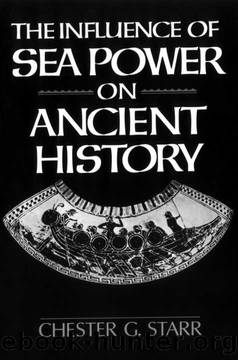The Influence of Sea Power on Ancient History by Chester G. Starr

Author:Chester G. Starr [Chester G. Starr]
Language: eng
Format: epub
By 301 the political structure of the Hellenistic world was beginning to take shape in three prominent dynasties: the Ptolemaic in Egypt; the Seleucid in Asia Minor, Syria, and on to the borders of India; and eventually the Antigonid in Macedonia. In the latter there was some sense of what may be called national loyalty; in the others Macedonian and Greek generals and bureaucrats controlled native populations for their own profit and power. The interstate relations of this era were as complicated in dynastic marriages and feuds as were those of early modern Europe and produced a great deal of hostilities by land and sea. Since the present study is not a general history we may pass lightly over specific wars; the manner in which sea power was used in practice led to a very unexpected result, that is, the destruction of the Hellenistic state system.
Not only were the political units much larger than the earlier Greek poleis, so too were the squadrons launched in Mediterranean naval warfare across the centuries to the final victory of Octavian in 31 B.c.; also the warships of the age were behemoths when compared to triremes. Early in the fourth century Dionysius of Syracuse had introduced ships called in Latin quadriremes and quinqueremes which evidently had sets of four and five rowers respectively. The usual interpretation is that instead of tugging individual oars as in the trireme larger groups manipulated great sweeps, the Venetian system a scaloccio, though in an alternative explanation quadriremes had two banks of two oarsmen each and a quinquereme two and three.3 Before the end of Athenian naval strength it too was building the larger ships, and Hellenistic navies came to be composed largely of quinqueremes, with crews of some 300 rowers, which were almost impregnable to attacks by the smaller old-style galleys.4 Indeed numbers of oarsmen crept up as far as 10 and 16; Ptolemy 11 even boasted a 40, which was probably a catamaran in construction, with groups of 20 rowers on each side, in a parade vessel.
This change was the consequence of two other alterations. In the first place crews especially of Egyptian ships were drafted from the countryside and had no naval training; more important perhaps was the revolution in tactics, which much reduced the reliance on maneuver, exhibited by Phormio and other com manders in the great days of Athenian thalassocracy. Warships now were fully decked and equipped with stone- and arrowthrowing machines and much larger complements of marines. It would not be exactly true to say, as one modern student does, that Hellenistic admirals "were content to see naval actions as opportunities for men in full armour to fight it out on deck,"6 for in the rather chaotic seafight off Chios in 201 there was a great deal of ramming and other maneuvers; but the statement can be applied, as we will see shortly, very aptly to Roman naval practice.
In the Hellenistic age economic interests played a more visible role in state policy. If
Download
This site does not store any files on its server. We only index and link to content provided by other sites. Please contact the content providers to delete copyright contents if any and email us, we'll remove relevant links or contents immediately.
| Africa | Americas |
| Arctic & Antarctica | Asia |
| Australia & Oceania | Europe |
| Middle East | Russia |
| United States | World |
| Ancient Civilizations | Military |
| Historical Study & Educational Resources |
The Bomber Mafia by Malcolm Gladwell(1184)
Submerged Prehistory by Benjamin Jonathan; & Clive Bonsall & Catriona Pickard & Anders Fischer(1162)
Facing the Mountain by Daniel James Brown(1136)
The Dawn of Everything by David Graeber & David Wengrow(1112)
The Way of Fire and Ice: The Living Tradition of Norse Paganism by Ryan Smith(1033)
Wandering in Strange Lands by Morgan Jerkins(1019)
Tip Top by Bill James(1004)
Driving While Brown: Sheriff Joe Arpaio Versus the Latino Resistance by Terry Greene Sterling & Jude Joffe-Block(1003)
Evil Geniuses: The Unmaking of America: A Recent History by Kurt Andersen(1001)
Red Roulette : An Insider's Story of Wealth, Power, Corruption, and Vengeance in Today's China (9781982156176) by Shum Desmond(1000)
F*cking History by The Captain(969)
It Was All a Lie by Stuart Stevens;(943)
White House Inc. by Dan Alexander(908)
Evil Geniuses by Kurt Andersen(903)
Treasure Islands: Tax Havens and the Men who Stole the World by Nicholas Shaxson(881)
American Dreams by Unknown(860)
American Kompromat by Craig Unger(850)
The Fifteen Biggest Lies about the Economy: And Everything Else the Right Doesn't Want You to Know about Taxes, Jobs, and Corporate America by Joshua Holland(817)
The First Conspiracy by Brad Meltzer & Josh Mensch(813)
